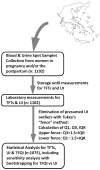Changes in Central Sensitivity to Thyroid Hormones vs. Urine Iodine during Pregnancy
- PMID: 39449406
- PMCID: PMC11503427
- DOI: 10.3390/medsci12040050
Changes in Central Sensitivity to Thyroid Hormones vs. Urine Iodine during Pregnancy
Abstract
Introduction/aim: Central sensitivity to thyroid hormones refers to the responsiveness of the hypothalamic-pituitary-thyroid (HPT) axis to changes in circulating free thyroxine (fT4). Although dose-response relationships between thyroid hormones per se and urinary iodine (UI) levels have been observed, central sensitivity to thyroid hormones in relation to UI remains unexplored. The aim of the present study was to evaluate central sensitivity to thyroid hormones (by means of the Thyroid Feedback Quantile-based Index [TFQI], which is a calculated measure, based on TSH and fT4, that estimates central sensitivity to thyroid hormones) in pregnancy and to assess whether it differs according to gestational age and/or iodine intake.
Materials and methods: One thousand, one hundred and two blood and urine samples were collected from pregnant women (with a mean age ± SD of 30.4 ± 4.6 years) during singleton pregnancies; women with known/diagnosed thyroid disease were excluded. Specifically, TSH and fT4, anti-thyroid peroxidase antibodies and UI were measured in each trimester and at two months postpartum, while the TFQI was calculated for all the study samples. After the elimination of outliers, statistical analysis was conducted with analysis of variance (ANOVA) for the variables versus time period, while Pearson's correlation was used to assess the TFQI versus UI.
Results: The mean TFQI index ranged from -0.060 (second trimester) to -0.053 (two months postpartum), while the corresponding UI was 137 and 165 μg/L, respectively. The TFQI-UI correlation was marginally negative (Pearson r: -0.323, p: 0.04) and significantly positive (r: +0.368, p: 0.050) for UI values over 250 μg/L, in the first and the second trimesters of pregnancy, respectively.
Discussion: The TFQI is a new index reflecting central sensitivity to thyroid hormones. A lower TFQI indicates higher sensitivity to thyroid hormones. In our sample, the TFQI was mainly positively related to iodine intake in the second trimester of pregnancy (following the critical period of organogenesis). Thus, the observed changes in the TFQI may reflect the different ways of the central action of thyroid hormones, according to the phase of pregnancy. These results have the potential to enhance our comprehension of the changes in the HPT axis' function via variations in central sensitivity to thyroid hormones and its interplay with nutritional iodine status during pregnancy.
Keywords: central sensitivity; free thyroxine (fT4); hypothalamic–pituitary–thyroid (HPT) axis; iodine intake; pregnancy; thyroid feedback quantile-based index (TFQI); thyroid hormones; urinary iodine excretion (UI).
Conflict of interest statement
The authors declare no conflicts of interest.
Figures



Similar articles
-
Thyroid Function Reference Values in Healthy Iodine-Sufficient Pregnant Women and Influence of Thyroid Nodules on Thyrotropin and Free Thyroxine Values.Thyroid. 2019 Mar;29(3):421-429. doi: 10.1089/thy.2018.0324. Epub 2019 Feb 22. Thyroid. 2019. PMID: 30693851
-
Iodine deficiency is associated with increased thyroid hormone sensitivity in individuals with elevated TSH.Eur Thyroid J. 2022 May 11;11(3):e210084. doi: 10.1530/ETJ-21-0084. Eur Thyroid J. 2022. PMID: 35324457 Free PMC article.
-
Urinary iodine excretion and maternal thyroid function. During pregnancy and postpartum.Saudi Med J. 2002 Apr;23(4):413-22. Saudi Med J. 2002. PMID: 11953767
-
Increased Serum Adipocyte Fatty Acid-Binding Protein Levels Are Associated with Decreased Sensitivity to Thyroid Hormones in the Euthyroid Population.Thyroid. 2020 Dec;30(12):1718-1723. doi: 10.1089/thy.2020.0011. Epub 2020 Jun 5. Thyroid. 2020. PMID: 32394790
-
The Association of Maternal Iodine Status in Early Pregnancy with Thyroid Function in the Swedish Environmental Longitudinal, Mother and Child, Asthma and Allergy Study.Thyroid. 2019 Nov;29(11):1660-1668. doi: 10.1089/thy.2019.0164. Epub 2019 Oct 10. Thyroid. 2019. PMID: 31524090
Cited by
-
ω9 Monounsaturated and Saturated Colostrum Fatty Acids May Benefit Newborns in General and Subtle Hypothyroid Stages.Nutrients. 2025 Jun 17;17(12):2017. doi: 10.3390/nu17122017. Nutrients. 2025. PMID: 40573128 Free PMC article.
References
-
- Koukkou E., Kravaritis S., Mamali I., Markantes G.G., Michalaki M., Adonakis G.G., Georgopoulos N.A., Markou K.B. No increase in renal iodine excretion during pregnancy: A telling comparison between pregnant women and their spouses. Hormones. 2014;13:375–381. doi: 10.14310/horm.2002.1487. - DOI - PubMed
-
- Croce L., Chiovato L., Tonacchera M., Petrosino E., Tanda M.L., Moleti M., Magri F., Olivieri A., Pearce E.N., Rotondi M. Iodine status and supplementation in pregnancy: An overview of the evidence provided by meta-analyses. Rev. Endocr. Metab. Disord. 2023;24:241–250. doi: 10.1007/s11154-022-09760-7. - DOI - PMC - PubMed
MeSH terms
Substances
LinkOut - more resources
Full Text Sources

